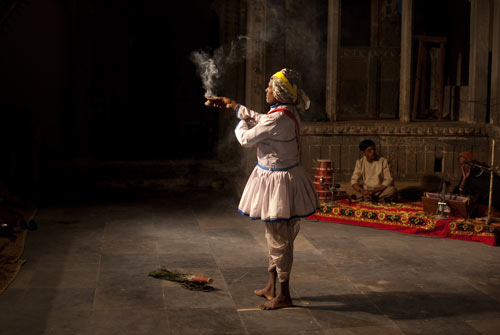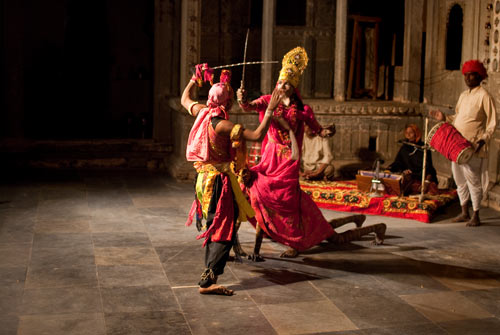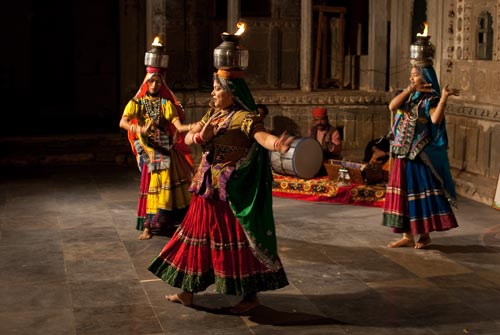Didn’t I Just Spot A Cow Tiptoeing Through An Open Drain?

Traveling in India for a while is challenging in so many ways for Westerners like David and me.
For example, one of the chief concerns that one has traveling about the country as we are is what one can and cannot safely drink and eat.
Everywhere in India one sees open drains in main streets and a complete lack of safe sanitation and plumbing. This is topped off by the animals on the street (including cows, bullocks, dogs, boars, goats, and the occasional elephant) who all use the roads in tandem with the very large human population.
From this you swiftly start appreciating what you’ve read in the guidebooks about being aware that anything cold that can be made or washed by water can be suspect and possibly contaminated.
Risking It All For Fresh, Raw Food
Still, although I’m being fastidious about only drinking either bottled or our UV-treated water, I must confess that I succumbed to fresh fruit salad and vegetable salads some days ago instead of solely eating hot food.
True, I only order such dishes at places that have good reputations for their hospitality. But I guess considering India’s reality, one is rolling the dice somewhat in any case. However, I can’t stand eating only cooked food and I’m not a fan of hot spices except in very small amounts. This makes eating in India challenging.
So, back to the fresh stuff I went.
Round One: The Buggies Are Victorious
Now whether it was eating that kind of food or getting used to the summer temperatures here in India after the winter cold of England that bothered my system I do not know.
However, I have been ill for some days now with strong abdominal pain and related problems that have seized me at times along with having a high fever a few nights ago that made me want to retreat forever. After bed rest, time, and using some local medicines, however, I’m finally feeling better.
For accuracy’s sake, I’ve included this negative experience. I figure overall that it’s worth recounting as evidence of what people must deal with when they are not lucky enough to live with a high standard of living to which Westerners like myself are so accustomed.
Round Two: Recovering, And Remembering The Good Stuff
Yet India has so much that is positive and marvelous – so now that I’ve returned to the world for the most part, I’d like to report a wonderful experience that I had earlier in the week.
Bagore Ki Haveli
Close to the haveli (i.e. a large traditional, ornately decorated home with a number of floors built around a courtyard which these days is often converted into a spacious guesthouse) in which we stayed in Udaipur is a much grander haveli called Bagore Ki Haveli.
Containing 138 rooms, it was built by Shri Chand Badwa who was prime minister of Mewar (the earlier name for Udaipur) in the mid-18th century.
The haveli was later taken over by the state and converted to a royal guest house. After India gained its independence in 1947, the Rajasthani government housed government servants in the haveli. Then in 1986, the building was converted to a museum to show the former royal lifestyle.
A Fabulous Folk Program in Udaipur
The museum is known for this folk program which is runs on every weeknight. On this particular evening, about 100 foreigners like myself were seated in the courtyard, some on benches and some reclining on Indian rugs that surrounded the large tree in the center.
Talking first in English and then in Hindi and speaking from one of the balconies as the stars shone above, a female presenter dressed in a lovely sari said a bit about each segment (including its traditional name) for the evening presentation.
Throughout the entire program, a singer and drummer performed background music to accompany all of the events of the evening.
Here is a bit more about this wonderful program that we saw:

A Dance Between Good and Evil
The first event presented a confrontational procession of sorts between good and evil.
Performed solely by men, two additional drummers kept a steady, constant beat going throughout the dance.
Each wore face paint and garishly colored costumes. One of them who was dressed like a woman with a veil and crown on his head was asked repeatedly through gesture by another performer to put stones that had been sitting in hot coals into his mouth.
He did so solemnly, carefully holding the red-hot stone between his front teeth for a moment or so before spitting each out. The procession ended with him riding off in triumph on his fellow performer who was kitted out as a horse.

Cymbals Played With Stones
The second event featured two women, one middle aged and one young woman.
Both sat down and faced the audience to perform. Dressed in fantastically colored saris adorned with sparkling jewelery, each had a row of cymbals running up the front of her calf, a cymbal on each hand, and another cymbal attached behind the shoulders. They also had short strings with stones attached, and it was this device that they used to play the cymbals. They also wore bell-adorned ankle bracelets.
As the musicians in the back played a feisty, lively tune, the women showed their skills at playing all of the cymbals with the stones. They jiggled their ankle bracelets in rhythm to their cymbal playing, synchronizing everything without missing a beat.
I for one had never seen cymbals placed strategically all over the body, nor had I seen them played as those women had.
Spinning With Fire
The third event featured three women.
Dressed in flowing skirts, they balanced brass pots with flames in them on top of their heads as they danced and spun around.

A Puppeteer’s Wizardry
The fourth event featured a puppeteer. With wonderful dexterity and great aplomb, the puppeteer first showcased a female puppet who wore a gypsy dress. Her moves were suggestive and flirtatious, and the puppeteer’s mastery of her gestures could be understood in any language.
The second puppet was a magician with the amazing ability to juggle his own head on his feet, on his outstretched arms, and on his back.
The sight was so ludicrous that again the audience was roaring with laughter.
Graceful Skirts In Technicolor
The fifth event featured seven women. Dressed with veils and gowns of several colors, they swirled and twirled as their skirts gracefully rose and fell with their movements.

Balancing Act Par Excellence
This time, however, she was showing us just how many terracotta water pots women are able to balance on their heads. In times and areas where water is hard to come by, our presenter explained, this skill is particularly valued and admired.
On top of the thick ring that people wear on top of their heads to balance such items, one by one the number of pots grew – until the dancer had 10 enormous pots on her head!
Not only did she dance about with the pots, but she also took off her shoes to stand on crushed glass at one point while at another point she stood on a metal dish and she put her feet on the edges while she wobbled forward.
Fellow Viewing
I was sitting next to a French woman. Not only was I having fun listening to her exclamations in French, but several times during this last event we spontaneously turned to one another as our jaws dropped in amazement at the dancer’s skill.
Learning More About The Puppeteer
The program ended, and David and I agreed that it was terrific. We hung about a bit afterwards, and then I noticed that the wonderful puppeteer was selling puppets.
I went up to him and complimented him on his fabulous performance. I asked him how long he had been a puppeteer, and he told me that his father, grandfather, and other relatives throughout past generations had been puppeteers.
He then switched the questions on me. After finding out that David and I live in England, he told me proudly that he has performed at the very highly-regarded Edinburgh Festival that takes place every summer in Scotland.
Meanwhile, I also had my eye on one of the puppets that he was selling which was the same magician with a removable head whom he had featured in his act.
When I said I was interested in buying it, he quickly released its strings and started to teach me how to do what he had done so wonderfully in the program.
Naturally, I was unable to do what he did and as he modestly said with a twinkle in his eye that it was ‘easy’ to do, I realised again just how much I love meeting and interacting with people cross-culturally like I had with this creative fellow.
Discovering Just How Much Those Water Pots Weighed
After I bought the puppet (ah, yes, I couldn’t resist), I asked a person who was dismantling the stage if there was a bag about that I could have for the puppet.
He kindly asked someone, and it then occurred to me that he might know something about the last event with the water pots.
“That woman who balanced all those water pots on her head – do you know how long has she been performing?” I asked.
“About 10 to 15 years,” he responded.
“And do you know how much those 10 water pots weighed?”
“About 13 kilos (30 pounds),” he said, grinning broadly.
In any culture, I venture to think, balancing that much on one’s head as one dances sure ain’t chicken feed!
Exiting The Darkened Courtyard
I took the plastic bag, wrapped the puppet with his purple body and separate head securely inside, grinned back at the guy – and walked out out of the now darkened courtyard with David, having experienced a deliciously magical night in India.